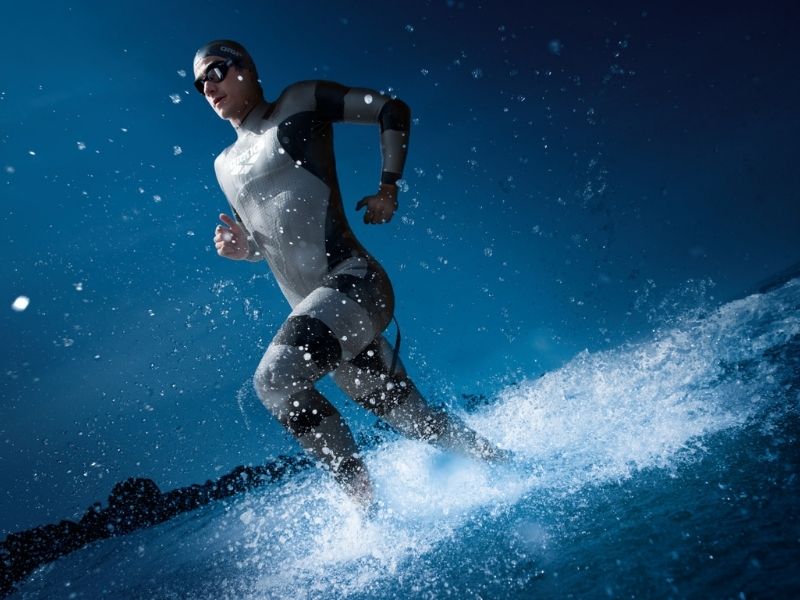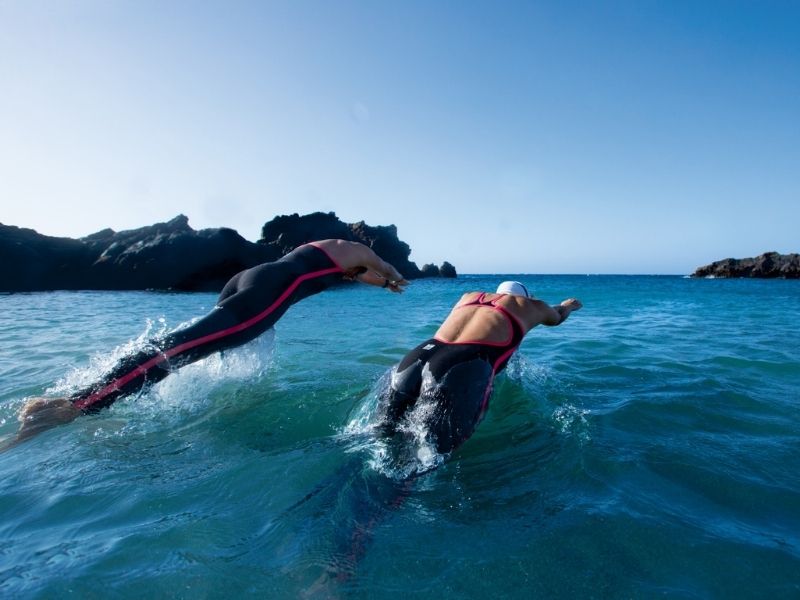Why You Should Be Wearing Thermal Swimwear in Open Water
Thermal swimwear is essential for open-water swimmers and triathletes. These specialized swimsuits will keep you safe and warm while training and competing. So, lose your jammers and regular old swimming suits and embrace the chilly, exciting world of open-water swimming!
Whether you are a seasoned triathlete or new to open-water swimming, choosing a thermal swimsuit is a big decision. After reading this, you will understand the important design characteristics of thermal swimwear. We will explore how thermal swimwear keeps you safe and healthy while swimming and how thermal swimsuits can help you swim faster. Plus, find out how to find the right fit and style for your needs so your new thermal swimsuit functions just right.
What Is Thermal Swimwear?
Thermal swimwear, also called wetsuits or thermal swimsuits, is designed with swimmers in mind. These wetsuits are similar to the ones used in scuba diving, surfing, and snorkeling. There are, however, a few key differences.
Like other wetsuits, thermal swimwear is designed to keep you warm in cold water. However, swimmers need wetsuits that allow for greater mobility in the shoulder area while maintaining buoyancy and warmth in key areas of the body. It would be awfully hard to complete an open-water event or triathlon in an 8mm diving wetsuit.
This mobility is achieved by using variable thicknesses in the neoprene of the wetsuit. When you select a thermal swimsuit made for open-water swimming, you will likely have a suit that uses thicker material in the legs and thinner material in the upper body. This allows for buoyancy and mobility while keeping you warm.
The fabric thickness in the legs will typically be in the range of 4mm or 5mm neoprene, but some suits can have more or less thickness depending on the specific swimmer’s needs. The upper body thickness is typically 2mm neoprene or 3mm neoprene but can be thicker or thinner depending on water temperature and the swimmer’s desired range of motion.
The Benefits of Using Thermal Swimwear
The use of thermal swimwear comes with a few major benefits. These wetsuits are designed to protect your body from cold conditions, keeping you safe and healthy on your swims. They also help you to swim faster and protect you from harmful UV rays. All of this keeps you healthy and happy doing what you love.
Thermal Swimwear Keeps You Safe and Helps to Prevent Injury
Like many sports in the great outdoors, open-water swimming has inherent risks. Learning about taking a safe swim in a lake or ocean is important before you begin swimming in open water. Thermal swimwear is a great way to ensure you are safely practicing the sport you love.
Water temperatures can get very cold in lakes and oceans. Swimmers are often under intense rates of cardiovascular exertion and are in a setting where athletic performance and physical safety are crucial. A thermal wetsuit could save your life, especially if you are swimming where no lifeguard is on duty.
Luckily, thermal swimsuits help to keep swimmers safe by regulating body temperature in cold conditions. This helps to prevent some very dangerous scenarios from occurring out in open-water. Brain and muscle function can become impaired if your body temperature drops too low, something you wouldn’t want to happen out in the ocean or lake.
A good wetsuit can also help to ensure muscles are operating at an appropriate temperature, preventing injury related to muscle strain. In a study by Bone and Joint Research, the findings support that “less energy is required to cause muscle tears” when muscle temperature drops below a certain point.
We all know a good warm-up is important before swimming, but when the water temperature is well below our body temperature that warm-up can become obsolete rather quickly. Equipping yourself with the appropriate thermal swimsuit could prevent you from becoming injured by keeping your muscles operating at a safe temperature.
Thermal Wetsuits Make You Faster

How could you say no to swimming faster? Some of us swim for competition and some of us swim for recreation, but we can all agree that cutting through the water faster than your previous swim is one of the most amazing feelings out there. It makes you feel healthy and on top of the world!
Buoyancy and muscle efficiency are the name of the game when it comes to increasing your speed. When we are more buoyant, our bodies are closer to the surface of the water, and we experience less drag. When our muscles are warm and firing on all cylinders, we maximize our propulsion through the water. A quality wetsuit will help you accomplish both of these things.
As mentioned earlier, thermal swimwear increases buoyancy in key areas of the body, particularly the legs. The greatest potential for drag comes in the form of your legs dropping and literally dragging behind you through the water.
While drag reduction should be worked on when training your swimming form, it certainly helps to have that extra flotation provided by 5mm neoprene holding your legs closer to the surface. In fact, a study conducted at Colorado State University found that “swim times were significantly reduced in both the 400- and 1500-m trials when the subjects were wearing the wetsuits.”
We already talked about the benefits of using a thermal wetsuit on muscle health, but how about muscle performance? That same warmth that keeps your muscles injury-free also plays a role in muscle exertion. A study published in the International Journal of Environmental and Science Education links warmer environmental temperatures to increases in muscle strength and flexibility.
A neoprene thermal swimsuit will keep essential heat close to your muscles so you can maximize your propulsion through the water. Pair that increased muscle strength with your additional buoyancy and you’ve got a recipe for faster swims. With good speed and great training sessions to improve your open-water endurance, you’ll be ready to get out there and crush your next swim or triathlon.
Thermal Swimwear Provides Sun Protection
If you are a seasoned swimmer, you know the importance of protecting yourself from the sun. If you are new to swimming, you should definitely think about UV protection. We normally think of sunscreen, a rash guard, or a bathing suit paired with a swim shirt for our basic sun protection needs, but wetsuits provide phenomenal sun protection as well.
Pair a long sleeve wetsuit with a swim cap and goggles that have mirrored outdoor lenses, and you’re ready to get out and enjoy the beauty of a long swim out in the sun. Don’t forget sunscreen for any exposed skin though — especially if you opt for a sleeveless style wetsuit.
Types of Thermal Swimwear

While there are many types of neoprene wetsuits, from short sleeve spring suits to full suits, or front zips and back zips, the two styles that dominate the open-water swimming and triathlon scenes are long-sleeve full suits and sleeveless suits. Both of these styles of thermal swimwear utilize full-length neoprene in the legs for increased buoyancy.
Deciding between using these two styles comes down to water temperature and personal preference. If you are swimming in very cold water, it is best to opt for a full-body wetsuit. This is the better choice due to the safety and performance reasons mentioned above. If the water you typically swim in is somewhat warmer, then you might opt for the sleeveless variation.
As for personal preference, it depends on whether you like to take your stroke with or without the sleeve. A sleeved wetsuit will have more buoyancy and warmth, but your stroke will feel less natural. On the other hand, sleeveless thermal swimwear will allow you to take your natural stroke if you don’t mind sacrificing that additional warmth and buoyancy.
How to Find the Appropriate Fit for Your New Wetsuit
If you’re looking for your first wetsuit, you might be wondering how it should fit. Your wetsuit should feel comfortable to move around in and should not restrict your normal mobility in the shoulders and legs. There should not be any loose fabric, as this would cause discomfort and drag while swimming.
When you try out a new wetsuit, there are a few things you should keep in mind to ensure it fits properly. First, check for any loose areas, especially around the shoulders and knees. Next, try running through some of your pre-swim stretches. If any of your normal stretching motions are difficult to complete, the wetsuit is likely too small. Try touching your toes and getting into a squat position. You should be able to complete these tasks without difficulty.
If you are new to thermal swimwear and have concerns about sizing, don’t worry! When you put on a wetsuit you will know if it is too small or too large. Trust the way your body feels in the suit and imagine yourself out for a swim. If you can’t imagine yourself completing your swim because of excessive tightness or because of chafing issues from the suit being too loose, try a different size. When you do find the suit that fits perfectly, you’ll know and be able to envision yourself out for a great swim.
Grab Your New Thermal Swimwear and Get Out There for a Swim

With a well-fitted wetsuit, you will be ready to get out there and enjoy the thrill of open-water swimming. A suit that fits you just right will feel like a second skin that keeps you warm and safe on all of your swims. It will not restrict your natural range of motion, and once you are out there, you won’t even notice it’s on.
Thermal swimwear will regulate your body temperature and keep your muscles warm, preventing injuries related to cold conditions. You’ll also be able to swim faster due to increased buoyancy and optimized muscle function. Thermal swimwear is the key to unlocking healthy, fast, and safe swims.
If you’re ready to give thermal swimwear a try, check out the full line of Arena wetsuits for men and women.
Written by:
Harrison Howarth
Harrison is a freelance writer with a background in competitive aquatic sports. His love for water polo and swim, combined with his passion for writing and education, drives him to continue teaching and inspiring individuals to participate in aquatics.







